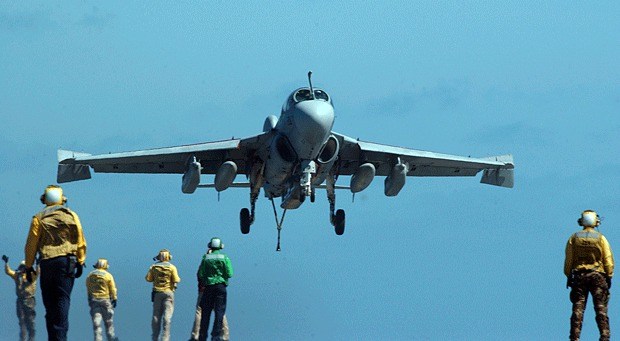A Whidbey Island Naval Air Station Prowler squadron is changing its aviation training program in the wake of news that “pilot error” was responsible for the March Prowler crash in Eastern Washington.
Three Electronic Attack Squadron (VAQ) 129 crewmembers who died in the March 11 EA-6B Prowler crash were the pilot, Lt. Valerie Delaney, 26; flight officer, Lt. William Brown McIlvaine III, 24; and instructor, Lt. Cmdr. Alan Patterson, 34.
A detailed report of the crash was released by the Navy’s Pacific Fleet headquarters in recent months, and included recommendations to changes VAQ-129 should make to its training program.
Patterson, a returning trainer, was placed into an “unnecessarily accelerated training” program without “normal oversight or formal review by existing standardization of procedures,” according to the report.
Recommendations listed in the report include the review and modification of instructor qualification, designation and tracking for VAQ-129.
“Practices that were in use on the day of the mishap were not in compliance” with published practices.
In addition, the squadron was asked to remove the provision allowing returning instructors to be given an accelerated syllabus.
“The syllabus is designed to provide the returning aviator sufficient opportunity in the aircraft to become reacquainted with critical pilot, copilot, instructor and general aviation skills that have atrophied during time away from the training environment.”
The Navy’s report also determined that the “substandard proficiency and syllabus compliance” of the students resulted in a “crew pairing that lacked optimal proficiency” for the difficulty level of the operation.
“As stated in the investigation, all three aviators were technically qualified for the event,” the report said. “However, when this crew was placed together in the low-altitude regime, their combined proficiency left them little margin for error.”
The report recommends that training be conducted to “emphasize proper student flight evaluation” utilizing detailed grade sheets and red flag students who may be showing signs they are having difficulty.
Despite specific circumstances that may have contributed to the crash, the Navy concluded that it was multiple factors that led to the fatal crash.
“Although a tragic loss of three aircrew, no specific action or inaction of any singular individual based on maliciousness, malpractice or negligence resulted in this mishap,” the report said. “Rather, a compilation of multiple events of assumed risk at various levels” lead to the final assessment that it was “pilot error.”
The Prowler crashed at approximately 8:45 a.m. in a rural area while conducting routine training approximately 50 miles west of Spokane, in Lincoln County.
In keeping with standard practice, a investigation was initiated by the Navy following the crash to determine the cause.
The Navy said that the mishap was not the result of any material failure of the Prowler.



